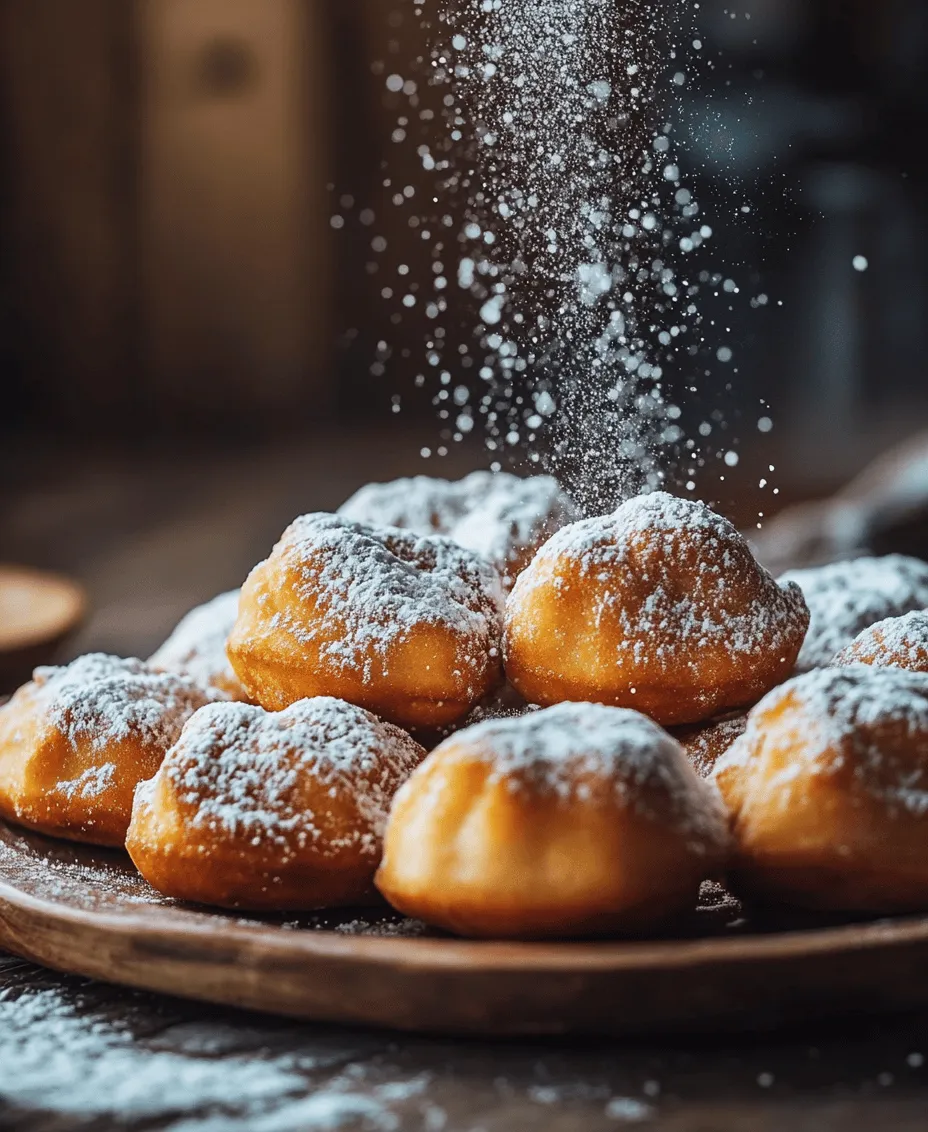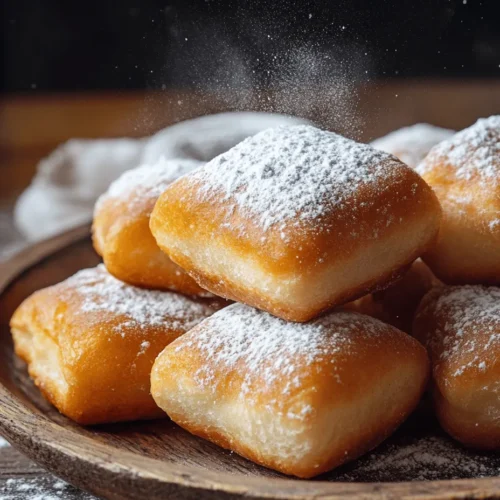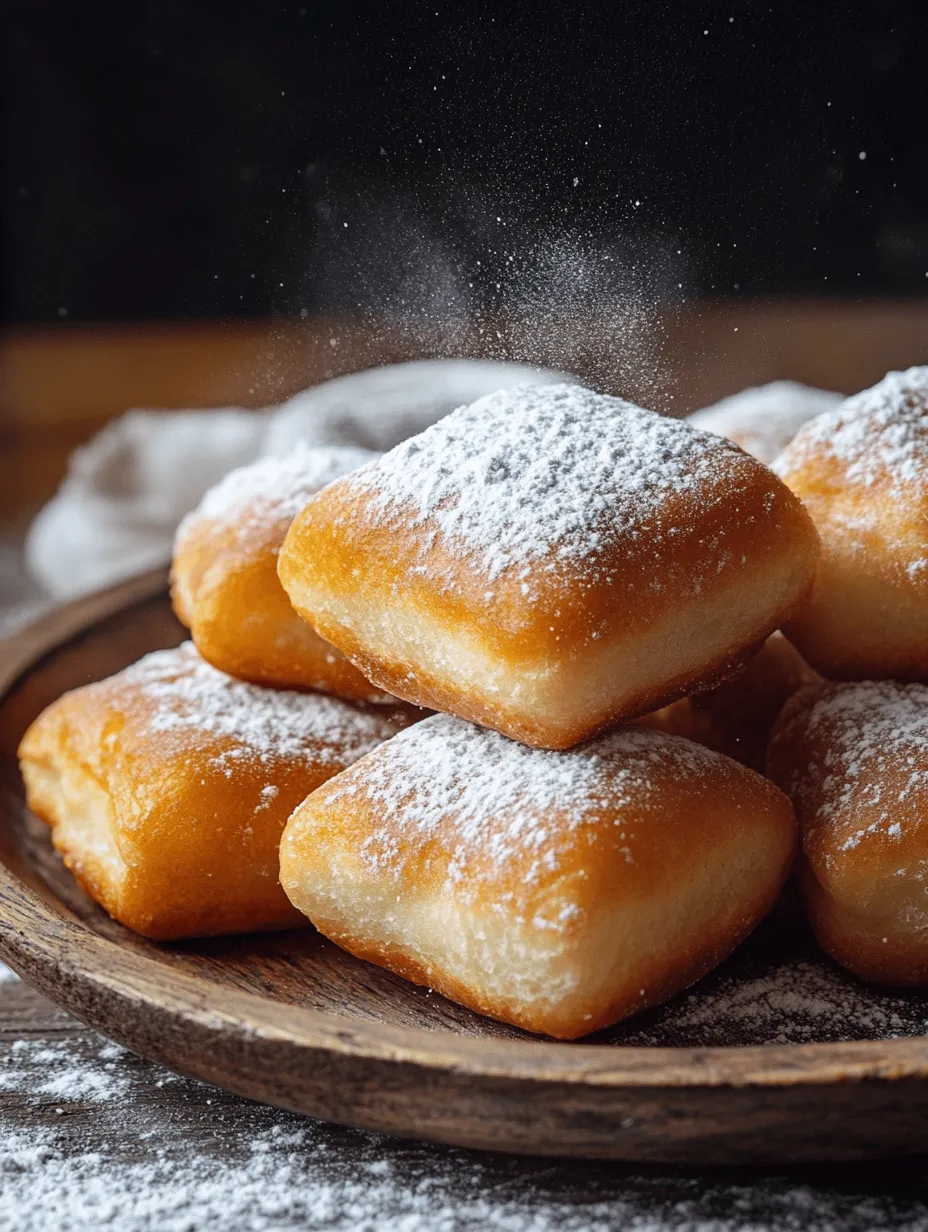Introduction
Welcome to the delightful world of beignets, a treat that transcends mere dessert status to offer a unique blend of history, culture, and mouthwatering flavor. These pillowy, deep-fried delights have become synonymous with indulgence, evoking a sense of nostalgia and comfort that makes them irresistible to anyone with a sweet tooth. This recipe, “Beignets Bliss: A Glazed Adventure,” invites you on a culinary journey that promises to deliver fluffy, sugar-dusted treasures right from your kitchen to your table.
Beignets are not just another pastry; they are a cultural icon, particularly in New Orleans, where they are a staple in the vibrant French Quarter. The combination of their light texture and the sweetness of powdered sugar creates a symphony of flavors and sensations that has captivated locals and tourists alike. Whether enjoyed with a cup of coffee or as a standalone treat, beignets embody the spirit of celebration and joy.
In this article, we will explore the rich history and cultural significance of beignets, break down the essential ingredients required to create these delectable treats, and provide you with a detailed step-by-step guide to making them at home. Get ready to embark on a satisfying and indulgent adventure that will elevate your baking skills and delight your taste buds.
The Allure of Beignets
Beignets have a fascinating history that traces back to ancient times, with variations found in different cultures around the world. The term “beignet” itself is derived from the French word for “fritter,” and its origins can be linked to the early settlers of France. The French brought their pastry traditions to North America, particularly to Louisiana, where the beignet found its perfect home.
In New Orleans, beignets became a beloved part of the city’s culinary landscape. They were popularized in the 18th century and have since become a quintessential treat, often associated with celebrations, festivals, and leisurely mornings. The iconic Café du Monde, established in 1862, serves beignets 24/7, attracting thousands of visitors each year who come to savor these fried delights with a side of chicory coffee. The warm, fluffy texture and the generous dusting of powdered sugar create an experience that is both comforting and indulgent.
Beyond New Orleans, various cultures have their own takes on the beignet. In Italy, for example, you can find “zeppole,” which are similar fried pastries often filled with cream. In Spain, you might encounter “buñuelos,” a type of fritter that is typically enjoyed during holidays and festivals. Despite the variations, the universal appeal of beignets lies in their ability to evoke joy and connection through shared culinary experiences.
Today, beignets have gained popularity in modern cuisine, appearing at brunches, food festivals, and gourmet bakeries. They are not just a seasonal treat; rather, they have become a year-round favorite for those seeking a taste of sweetness. With the rise of social media, beignets have also found their way into the limelight, with countless food bloggers and influencers showcasing their unique spins on this classic recipe.
Ingredients Breakdown
To create the perfect beignets, you will need a selection of key ingredients that work together to achieve that signature fluffy texture and delightful flavor. Here is a detailed breakdown of each ingredient:
All-Purpose Flour: The Foundation of the Dough
All-purpose flour is the backbone of the beignet dough, providing the structure and stability needed for these pastries to rise and hold their shape. The protein content in all-purpose flour, which typically ranges between 10-12%, strikes a balance between tenderness and strength, making it ideal for frying.
Buttermilk: Adding Richness and Flavor
Buttermilk plays a crucial role in enhancing the flavor and texture of the beignets. Its acidity helps to tenderize the dough while also contributing a subtle tanginess that balances the sweetness of the sugar. Additionally, buttermilk’s fat content adds richness, resulting in a more decadent treat.
Granulated Sugar: Sweetness Balance
Granulated sugar not only adds sweetness to the beignet dough but also helps to create a crispy golden crust when fried. The sugar caramelizes during the frying process, giving the beignets their signature exterior texture. It’s important to find the right balance of sweetness, as the powdered sugar topping will also contribute to the overall flavor of the finished product.
Salt: Enhancing Overall Flavor
Salt is an essential ingredient in baking, as it enhances the flavors of the other ingredients. In beignets, a pinch of salt helps to elevate the sweetness and provides a well-rounded taste. It is important to use the right amount of salt to ensure that it complements rather than overwhelms the other flavors.
Baking Powder and Baking Soda: Role in Leavening
Both baking powder and baking soda are leavening agents that work together to create lift and fluffiness in the beignet dough. Baking powder contains both an acid and a base, allowing it to produce carbon dioxide gas when mixed with liquid, while baking soda requires an acidic ingredient (like buttermilk) to activate it. This combination results in a light and airy texture that is characteristic of good beignets.
Egg: Binding and Texture Contributor
Eggs serve as a binding agent in the beignet dough, helping to hold all the ingredients together while also contributing moisture and richness. The proteins in the egg also aid in the structure of the beignets, ensuring that they maintain their shape during frying.
Unsalted Butter: Richness and Moisture
Incorporating unsalted butter into the dough adds a layer of richness and moisture to the beignets. The butter contributes to the overall tenderness of the pastry and enhances the flavor profile. Using unsalted butter allows for better control over the salt content in the recipe.
Oil for Frying: Importance of the Right Frying Oil
The choice of oil for frying is crucial for achieving the perfect beignet. A neutral oil with a high smoke point, such as canola or vegetable oil, is ideal for frying beignets. This ensures that the pastries cook evenly without imparting any unwanted flavors. The right oil will also help achieve a crispy exterior while keeping the inside fluffy and tender.
Powdered Sugar: The Finishing Touch for Sweetness
No beignet is complete without a generous dusting of powdered sugar. This sweet finishing touch not only adds flavor but also contributes to the visual appeal of the pastries. The powdered sugar creates a beautiful contrast against the golden-brown beignets, making them even more enticing.
Discussion of Ingredient Substitutions for Dietary Preferences
As with any recipe, there are opportunities to customize the ingredients based on dietary preferences. For those seeking a gluten-free option, consider using a gluten-free all-purpose flour blend that contains xanthan gum to help mimic the texture of traditional flour. Additionally, non-dairy milk can be substituted for buttermilk, and egg replacements like flaxseed or chia seeds can be used to cater to vegan diets.
Step-by-Step Instructions for Beignets
Now that we’ve covered the essential ingredients, it’s time to dive into the step-by-step process of creating these delightful beignets. The following instructions will guide you through each stage, ensuring that you achieve the perfect batch of fluffy, glazed pastries.
1. Prepare the Dough:
– In a large mixing bowl, combine the all-purpose flour, granulated sugar, salt, baking powder, and baking soda. Whisk the dry ingredients together until well combined.
– In a separate bowl, whisk together the buttermilk, egg, and melted unsalted butter until smooth.
– Gradually add the wet ingredients to the dry ingredients, mixing until just combined. Be careful not to overmix, as this can lead to dense beignets.
2. Knead the Dough:
– Turn the dough out onto a lightly floured surface and gently knead it for about 1-2 minutes, just until it comes together. The dough should be soft and slightly sticky but not overly wet. If it feels too sticky, you can sprinkle a little extra flour as needed.
3. Roll and Cut the Dough:
– Using a rolling pin, roll the dough to about 1/2 inch thickness. Use a sharp knife or a pastry cutter to cut the dough into squares or rectangles, approximately 2-3 inches in size.
4. Heat the Oil:
– In a deep frying pan or a heavy-bottomed pot, heat about 2-3 inches of oil over medium heat. Use a thermometer to ensure the oil reaches a temperature of 350°F (175°C) for optimal frying.
5. Fry the Beignets:
– Carefully drop the cut dough pieces into the hot oil, being mindful not to overcrowd the pan. Fry the beignets for about 2-3 minutes on each side, or until they are golden brown and puffed up. Use a slotted spoon to remove them from the oil and transfer them to a plate lined with paper towels to drain any excess oil.
6. Dust with Powdered Sugar:
– While the beignets are still warm, generously dust them with powdered sugar. For an extra touch of indulgence, you can coat them in a second layer of powdered sugar for a delightful sweetness.
7. Serve and Enjoy:
– Serve the beignets warm with a side of coffee or your favorite beverage. Enjoy the satisfying experience of biting into a fluffy pastry, dusted in sugar, and bursting with flavor.
With these detailed instructions, you’re well on your way to creating your very own batch of beignets at home. The process may seem intricate, but the reward is a delightful treat that is sure to impress family and friends alike. Stay tuned for the next part of this article, where we will delve into tips for achieving the best results and answer some common questions about beignets.

Mixing Dry Ingredients: Importance of Proper Blending
The process of making beignets begins with mixing the dry ingredients. This step is crucial because it helps create a uniform flavor and texture throughout the dough. In a medium-sized bowl, combine all-purpose flour, granulated sugar, baking powder, and salt. Whisk these ingredients together thoroughly to ensure that the baking powder is evenly distributed. This is important because if the leavening agent is concentrated in one area, you may end up with unevenly risen beignets.
Proper blending of the dry ingredients also enhances the overall flavor profile. The sugar helps to slightly sweeten the dough, while the salt balances the sweetness and accentuates the flavors. Taking the time to mix these ingredients well will set the stage for the next steps in your beignet-making adventure.
Combining Wet Ingredients: Achieving the Right Consistency
Once your dry ingredients are well-blended, it’s time to move on to the wet ingredients. In a separate bowl, combine warm water, yeast, and milk. Allow the mixture to sit for about 5-10 minutes until it becomes frothy. This step is essential as it activates the yeast, which will help your beignet dough rise appropriately.
After the yeast has activated, add in the egg and melted butter, mixing until well combined. Slowly incorporate the wet mixture into the dry ingredients. Use a spatula or wooden spoon, stirring gently until the dough begins to come together. The goal is to achieve a soft, slightly sticky dough. If the dough feels too dry, you can add a little more milk or water, one tablespoon at a time, until the desired consistency is reached.
Forming the Dough: Tips for Handling and Rolling
Once the dough is fully combined, transfer it onto a lightly floured surface. Here, you’ll want to knead the dough gently for about 5 minutes until it becomes smooth and elastic. Be careful not to over-knead, as this can lead to tough beignets. The dough should feel soft to the touch and spring back when poked.
After kneading, shape the dough into a ball and place it in a lightly greased bowl. Cover it with a clean kitchen towel or plastic wrap to prevent it from drying out. Allow the dough to rise in a warm, draft-free area for about 1-2 hours, or until it has doubled in size. This step is crucial for achieving those fluffy, light beignets that are so beloved.
Cutting the Beignets: Shapes and Sizes for Different Preferences
After the dough has risen, it’s time to cut the beignets into shapes. On a floured surface, roll out the dough to about a half-inch thickness. Using a sharp knife or a pizza cutter, cut the dough into squares or rectangles, typically about 2-3 inches in size. For a classic look, you can even use a beignet cutter or biscuit cutter for perfectly shaped rounds.
Feel free to experiment with different shapes and sizes. Smaller beignets make great bite-sized treats for parties, while larger ones can be a centerpiece for a sweet brunch. The possibilities are endless, and the fun is in the creativity!
Frying Process: Temperature Control and Safety Tips
Frying is where the magic happens! Heat vegetable oil in a deep fryer or a heavy-bottomed pot to a temperature of 350°F (175°C). Using a thermometer is highly recommended to ensure the oil reaches the correct temperature. If the oil is too hot, the beignets will burn on the outside while remaining raw on the inside; if it’s too cool, they’ll absorb too much oil and become greasy.
When ready, carefully lower a few beignet pieces into the hot oil, making sure not to overcrowd the pot. Fry them for about 2-3 minutes on each side or until they turn a beautiful golden brown. Use a slotted spoon to flip them gently, ensuring even cooking.
Safety is paramount during frying. Always keep a close eye on the oil and never leave it unattended. Have a fire extinguisher nearby, just in case, and remember to keep a lid on the pot close by to smother any potential flare-ups.
Draining and Cooling: Ensuring Perfect Texture
Once the beignets are golden brown, use a slotted spoon to remove them from the oil and place them on a plate lined with paper towels. This will help drain any excess oil, ensuring that your beignets are light and fluffy rather than oily.
Let them cool for a few minutes before glazing. However, while they are still warm, they are best for glazing, as this allows the glaze to adhere better and enhances the flavor. This cooling process is crucial as it prevents the beignets from becoming soggy, maintaining that desirable texture.
Glazing Techniques: Various Options for Flavoring and Presentation
Now comes the fun part: glazing your beignets! There are countless options for glazes, from traditional powdered sugar to creative flavor variations. The classic choice is a simple glaze made from powdered sugar and milk, creating a smooth and sweet coating that enhances the beignet’s flavor.
The Glazing Adventure
When it comes to glazing, the world is your oyster. For a traditional glaze, whisk together powdered sugar and milk until smooth. Adjust the consistency by adding more sugar for thickness or milk for a thinner glaze.
If you want to get more adventurous, consider infusing flavors into your glaze. Here are a few options to try:
– Chocolate Glaze: Melt semi-sweet chocolate and mix it with a bit of cream until smooth.
– Vanilla Glaze: Add a splash of vanilla extract to your basic glaze for a more aromatic flavor.
– Fruit-Infused Glaze: Use fruit juices or purees, like raspberry or orange, to add a fruity twist to your glaze.
When glazing your beignets, dip them into the glaze while they are still warm, allowing the glaze to coat them evenly. For a final touch, dust with additional powdered sugar for visual appeal and added sweetness.
Serving Suggestions
Beignets are best enjoyed fresh, but they are versatile enough to be served in various ways. Here are some creative ideas for serving your delicious treats:
– Pairing with Beverages: Beignets make an excellent accompaniment to coffee, tea, or hot chocolate. The rich flavors complement each other wonderfully, making for a delightful breakfast or afternoon snack.
– Serving at Special Occasions: These fluffy pastries are perfect for brunches, parties, or holiday gatherings. Consider arranging them on a decorative platter with a selection of glazes for guests to dip into.
– Presentation Ideas for a Festive Touch: For a festive presentation, consider serving the beignets in a rustic basket lined with a cloth napkin. You can also use decorative toothpicks for easy grabbing and a touch of elegance.
Nutritional Information
As with any indulgent treat, moderation is key when enjoying beignets. Here’s a breakdown of the nutritional content per serving (approximately 2 beignets):
– Calories: 250
– Total Fat: 14g
– Saturated Fat: 8g
– Cholesterol: 35mg
– Sodium: 160mg
– Total Carbohydrates: 28g
– Sugars: 10g
– Protein: 3g
While beignets are certainly a sweet indulgence, it’s worth noting that they can be enjoyed in moderation as part of a balanced diet. Compared to other desserts, beignets can be slightly lower in calories, especially when you opt for lighter glazing options.
Conclusion
Making beignets is not just about the end product; it’s about the joy of the process and the delightful experience of enjoying these treats. The fluffy texture, the sweet glaze, and the endless possibilities for flavor variations all contribute to the charm of this classic dessert.
As you embark on your beignet-making adventure, don’t hesitate to experiment with flavors and styles. Whether you stick to the traditional approach or get creative with your glazes, the comfort and satisfaction that comes from making and enjoying beignets is truly unparalleled. So gather your ingredients, invite friends or family, and indulge in the blissful experience of creating these delightful pastries together. Happy frying!


